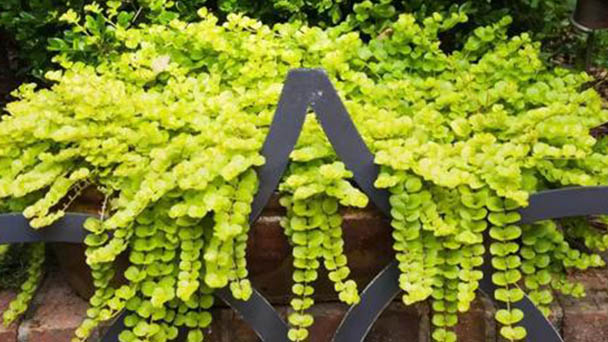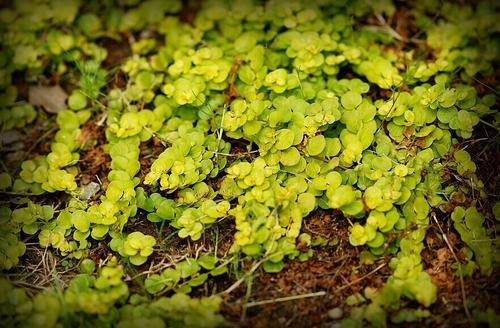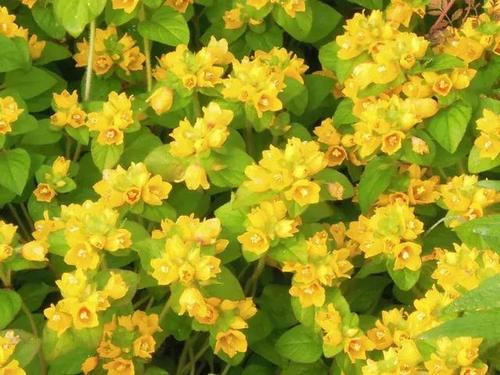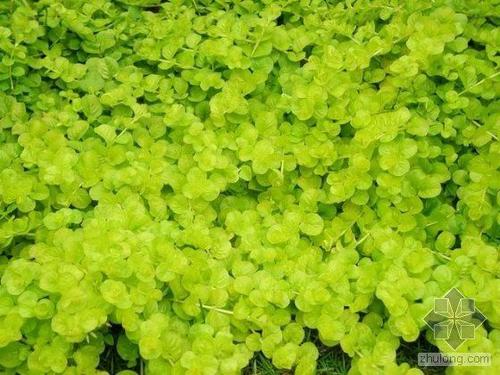Creeping Jenny profile
Written by Maggie
Aug 24 2021

Creeping Jenny, scientific name Lysimachia nummularia, is a plant to peep Jenny. Creeping Jenny is a primrose, perennial, evergreen herb with Creeping branches and about five centimeters in height.
Creeping Jenny picture
Morphological characteristics of creeping Jenny
Creeping Jenny (Lysimachia nummularia) is a perennial evergreen herb with persistent roots. creeping jenny is about 5 cm tall, stolon cylindrical, clustered, apex elongated into whip, up to 50-80 cm long. Leaves are simple, opposite, ovate or broadly ovate, 1.5-4 cm long, 1.2-3 cm wide. Leaves are golden in color from March to November, dark red at low temperatures.
Flowers are solitary in midstream axles, tip upturned into a cup, corolla bright yellow, 7-15 mm long, base connate part 2-4 mm long, lobes narrowly ovate to sublanceolata, apex acute or obtuse, slightly thick texture, with long black glandular flower diameter about 2 cm, because of color and leaf color close. Calyx of Creeping Jenny is (4) 5-7 (10) mm long, divided nearly to base, lobes lanceolate, elliptic-lanceolate to linear or distally slightly enlarged and subspatulate, apex acute or slightly obtuse, glabrous, pilose or marginally ciliate only; Filaments of Creeping Jenny are 6 -- 8 mm long, lower part connate into tube; Anthers are ovoid, 1-1.5 mm long; Pollen grains of Creeping Jenny are with 3-well furrows, subglobose, surface with reticulate ornamentation; Ovary is ovoid, style 6-8 mm long. Capsule is globose, 4-5 mm in diam., glabrous, with sparse black glandular strips.
Origin and habitat of Creeping Jenny
Creeping Jenny (Lysimachia nummularia) is native to Europe, the eastern United States and other places, widely cultivated in China.
Creeping Jenny growth habit
Creeping Jenny (Lysimachia nummularia) is extensively managed colored leaf cover that is drought tolerant, adaptable to the environment, tolerant to light and semi-shade, and optimal for growth at 15 to 30 °C.Creeping Jenny generates roots and has a habit of peeping in on each of the leaves. Creeping Jenny has a longer growth period, faster growth rate, and can tolerate temperatures of -15℃.

Propagation of creeping Jenny
Creeping Jenny (Lysimachia nummularia) is propagated mainly by cuttings in the growing season, with a survival rate of over 90 percent. Read more about Creeping Jenny propagation.
Creeping Jenny growing methods
Weeding: Before the ground is closed, weeds should be pulled out in time. After the ground closed weeding management can be normal.
Water: Creeping Jenny's seedlings: Watering "dry, water thoroughly," to ensure that buried stems absorb sufficient water to peep in and peep out roots to survive and germinate. In the hot summer to strictly control the moisture content of the seedbed, rather dry rather than wet, to prevent the emergence of high temperature and high humidity of the seedbed microclimate.
Fertilizer: after hair root of Creeping Jenny (Lysimachia nummularia), it should be used in time with 0.3% hydrogen phosphate 2 potassium or superphosphate 100 times liquid spray 2-3 times, press 3-5 grams/square meter dosage at the right time topcoat urea, pour again permeable.
Trim: Creeping Jenny (Lysimachia nummularia): Consider thinning or cutting to peep in on the plant when it is fully covered. More about Creeping Jenny Care.
Creeping Jenny application
Creeping Jenny (Lysimachia nummularia) is a promising ground cover that will last nine months and provide strong growth, fewer pests and diseases, and protection from reformation of soil dust. Creeping Jenny is also an excellent color foliage plant.

Latest Updated
- Benefits of Bugleweed - 7 Science-backed Health Benefits
- Bugleweed Dangers & Side Effects - Is It Poisonous?
- How to Plant Evergreen Trees - What You Should Know
- When to Plant Evergreens - Grow Guide for Evergreen Trees
- 12 Wonderful Evergreen Shrubs for Your Garden
- 12 Popular Evergreen Plants with Pictures for Beginners
- When And How To Prune A Lilac Bush Like a Pro
- How to Grow & Care for Lilac Vine (Hardenbergia Violacea)
- Japanese Lilac Tree (Syringa Reticulata) Care & Propagation Guide
- Shumard Oak Pros and Cons - What to Know
Popular Articles
- Winter maintenance of Antirrhinum Majus
- How to Grow Terminalia Mantaly Tree
- How to Grow and Care for Crossostephium Chinense
- How to grow Antirrhinum Majus in spring
- Peristeria Elata (Dove Orchid) Profile: Info & Care Guide
- Underwatered Snake Plant (Sansevieria Trifasciata) - Signs And How To Fix
- How to Care for Brazilian Jasmine Plant (Mandevilla Sanderi)
- How to Grow & Care for Graptopetalum Purple Delight in Summer
- Rosa Chinensis (China Rose): Plant Growing & Care Tips
- How to Care for Baby Sun Rose (Aptenia Cordifolia)
